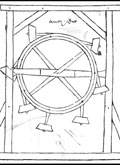Chinese Inventions
Chinese People are always known for their capacity of inventions, they have designed new machines and many different products to be used in our daily life. All these inventions occurred many centuries ago. The input of the Ancients Chinese, has been recognized by our society, but has created many doubts among us about if actually Chinese people were the real inventors of such amazing tools, such as the Compass and the Gunpowder.
I. Compass
1. The Finding of the compass has been a doubt, since history had brought to us that probably others like Arab or European besides the Chinese may had also invented the Compass, since the primeval compasses agree with any of these primitive cultures. In certain sources such as “Chinese inventions that rocked the world." Talks about that the compass was design by Ancients Chinese to pinpoint directions in an accurate way.
a) Being Invented by Ancient Chinese between 770 and 221 B.C.
b) The first compasses were called, “South-pointers”.
c) The Compasses shapes were later changed from spoon-shaped stones to magnetic needles making them easier to be carried.
d) Also, in “Pointing to the Future.” European Alexander Neckman had mention the Compass for the first time in 1180 calling it, “The lodestone needle.” Which it was mounted on a cork and allowed to float in a bowl of water. This idea flows later in 1269. The Compass has fascinated the world, and had made possible all voyages in the ocean and the discovery of new places such as Continents, islands, and other types of land. The Compass has becoming one of the greatest inventions that the world possesses and it had contributed to our society and especially for the U.S. Navy and to make new discoveries.
II. Gunpowder
2. Ancient Chinese Alchemist, were trying to invent something that would make them live eternally, but accidentally they invented a chemical that explodes. After this, this invention has taken part in many of the world self-destructions “The War.” These inventions have contributed to the self-destruction of the human being. When gunpowder was invented, we have not realized that we have created a weapon against the human being, which is indestructible. They were two types of Gunpowder: Mining Gunpowder that was used many century ago and Gunpowder that it still being use now a days.
a) Before the invention of the Gunpowder by Ancients Chinese, they believe that the first use of Mining Gunpowder was the technique used by Joshua to capture Jericho in year 72 AD. According to some historical assumptions.
b) “ Mining,” which consisted of excavating a passageway or gallery below the ground, once completed it was fill out with flammables materials in order to collapse, capture, and kill their enemies. This method was used by the Jewish Army against the Roman forces of Vespasian in A.D. 72. The Military Mining operations first used the gunpowder mines around the year 1250; this had replaced the flammables by seeing remarkable results used against the Italians towards the end of the 15th century.
c) The Gunpowder, as some say we believe it was invented by the Ancients Chinese. They created a mixture called “Huo Yao” or Fire Chemical, Huo Yao was invented between A.D. 150 and 850. Alchemist Chinese added a different chemical to the mixture making it more powerful gunpowder, this chemical is called Saltpeter. The latest gunpowder was made by saltpaper, charcoal, and sulfur.
d) Gunpowder has been through history an important invention, and it has been used against our enemies to defend ourselves. Gunpowder has been present in all type of war that it is in History after the year 72 AD.
In conclusion, Compass and Gunpowder have attributed to our society throughout the history. They both have played an important role to humanity. The discovery of the compass and gunpowder has been one of the biggest wins we've had, but at the same time has been a weapon of self-destruction.
Source Citation
Anderson, Leigh. "The Fab 4: Chinese inventions that rocked the world." Appleseeds Jan. 2008: 24+. General OneFile. Web. 31 Oct. 2011.
Document URL
http://go.galegroup.com/ps/i.do?&id=GALE%7CA177056777&v=2.1&u=lincclin_mdcc&it=r&p=ITOF&sw=w
http://go.galegroup.com/ps/i.do?&id=GALE%7CA177056777&v=2.1&u=lincclin_mdcc&it=r&p=ITOF&sw=w
"Pointing To The Future. (Cover Story)." Economist 353.8151 (1999): 98. Academic Search Complete. Web. 3 Nov. 2011.
<!--Additional Information:
Persistent link to this record (Permalink): http://db16.linccweb.org/login?url=http://search.ebscohost.com/login.aspx?direct=true&db=a9h&AN=2623253&site=ehost-live
Baker, David Christopher. "The Great-Grandfather Of Modern Land Mines Might Well Be A Tunnel Under Jericho." Military History 19.1 (2002): 20. Academic Search Complete. Web. 3 Nov. 2011. Persistent link to this record (Permalink): Persistent link to this record (Permalink): http://db16.linccweb.org/login?url=http://search.ebscohost.com/login.aspx?direct=true&db=a9h&AN=6097375&site=ehost-live
